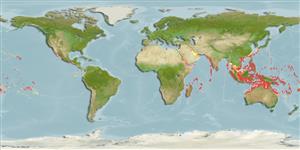Common names from other countries
>
Syngnathiformes (Pipefishes and seahorses) >
Syngnathidae (Pipefishes and seahorses) > Nerophinae
Etymology: Dunckerocampus: From Duncker, an ichthyologist and taxonomist that recognized four Gobiidae families (1928) + Gr, kampe = bent.
More on author: Bleeker.
Environment: milieu / climate zone / depth range / distribution range
Ecología
marino asociado a arrecife; rango de profundidad 5 - 56 m (Ref. 1602). Tropical; 33°N - 26°S
Indo-Pacific: Red Sea and East Africa to Samoa, north to Japan (Ref. 559), south to Australia.
Tamaño / Peso / Age
Maturity: Lm ? range ? - ? cm
Max length : 19.0 cm TL macho / no sexado; (Ref. 4281)
Espinas dorsales (total): 0; Radios blandos dorsales (total): 20-26; Espinas anales 0; Radios blandos anales: 4. Usually with one dark band crossing opercle (Ref. 4281).
Adults inhabit tide pools, lagoons, and outer reef slopes. Found in caves and crevices. Ovoviviparous (Ref. 205). Feeds on small invertebrates (Ref. 89972). The male carries the eggs in a brood pouch which is found under the tail (Ref. 205). Have been reared in captivity (Ref. 35416). Solitary, pairs or in small aggregations in caves or under ledges (Ref 90102).
Life cycle and mating behavior
Madurez | Reproducción | Puesta | Huevos | Fecundidad | Larva
Male carries the eggs in a brood pouch (Ref. 205).
Myers, R.F., 1991. Micronesian reef fishes. Second Ed. Coral Graphics, Barrigada, Guam. 298 p. (Ref. 1602)
IUCN Red List Status (Ref. 130435)
CITES (Ref. 128078)
Not Evaluated
Threat to humans
Harmless
Human uses
Acuario: Acuarios públicos
Más información
ReferenciasAcuiculturaPerfil de acuiculturaRazasGenéticaElectrophoresesheritabilidadEnfermedadesProcesamientoMass conversion
Herramientas
Special reports
Download XML
Fuentes de Internet
Estimates based on models
Preferred temperature (Ref.
115969): 24.8 - 29, mean 27.8 (based on 672 cells).
Phylogenetic diversity index (Ref.
82804): PD
50 = 0.5078 [Uniqueness, from 0.5 = low to 2.0 = high].
Bayesian length-weight: a=0.00085 (0.00032 - 0.00224), b=3.04 (2.81 - 3.27), in cm Total Length, based on LWR estimates for this (Sub)family-body shape (Ref.
93245).
Nivel trófico (Ref.
69278): 3.8 ±0.55 se; based on food items.
Resiliencia (Ref.
120179): Alto, población duplicada en un tiempo mínimo inferior a 15 meses (Preliminary K or Fecundity.).
Fishing Vulnerability (Ref.
59153): Low vulnerability (10 of 100).
